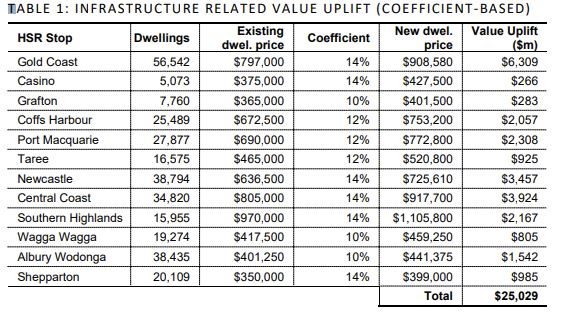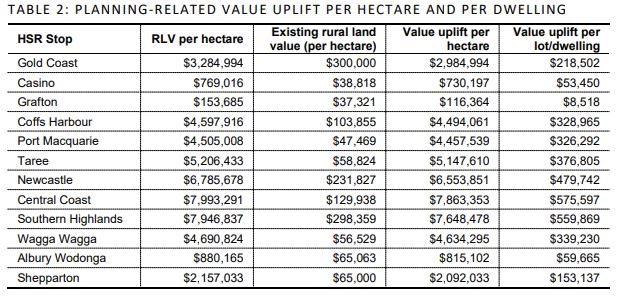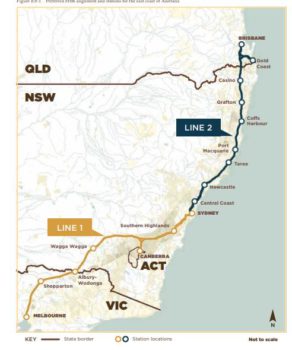A high speed-rail network on the east coast of Australia could boost land value and property prices around high-speed stations by up to $140 billion, preliminary research suggests.

The growth in land value could be used to fund the high speed rail projects and support the creation of more liveable cities and regions, an investigation report from the University of NSW, based on a combination of infrastructure and planning-related value uplift calculations, has found.
“From our estimates of infrastructure-related value uplift combined with our ‘what if’ scenarios for planning-related value uplift, there could be potential value uplift in the vicinity of $48 billion to $140 billion,” the report concludes.
“Therefore, we put forth there is substantial opportunity to fund high speed rail through value uplift.”
The analysis is based on proposed high speed rail lines running from Melbourne to Sydney (by 2040) and Sydney to Brisbane (by 2058), with spur lines to Canberra and the Gold Coast.
Creating premium properties
One of the report’s authors, UNSW City Futures Research Centre director Chris Pettit, said the value uplift in land around a high speed rail network could create premium properties because of faster and easier access to the CBD.
“Value uplift relates to the increase in land and property value attributed to a new piece of infrastructure that’s gone in,” Professor Pettit told Government News.
“It’s that measurable amount of property value increase that can be attributable to a transformational piece of infrastructure, like a metro line or a light rail.
“That accessibility to public transport, to a high quality transport like a metro, people will pay a premium for that.”


For the purposes of their study, their definition of high-speed rail was that it “operate(s) on dedicated tracks at a maximum speed of between 250 and 300 kilometres per hour, with some systems now operating in excess of 300 kilometres per hour”.
Liveable regions
A high-speed rail network could also help manage Australia’s population growth and create vibrant, liveable regional centres

“If you look at the high-speed rail in Europe that connects León in through to Paris, there’s been benefits both for Paris as well as León and the other stations, so we’re seeing benefits flowing both ways,” Professor Pettit said.
“At the Research Centre, we think high speed rail could really be a nation building project if it’s done properly and provide a backbone for this future Australian growth corridor,” Professor Pettit said.
“If you don’t have high quality infrastructure to connect people to the existing amenity of Canberra, Brisbane, Sydney and Melbourne, it can be quite hard to set up quite vibrant, high growth, regional cities and centres.”
Around the world, high-speed rail networks have become centres of attraction for new businesses and retail shops, he says.
“In Japan…as they move to a very compact city form development, the vibrancy of those stations, as high speed rail stations in their own right, have become quite vibrant mini cities, and that connectivity and flow of people creates its own vibrancy.”
Integrated funding
Professor Andrew McNaughton, Chairman of Network Rail (High Speed) which manages UK’s high speed line HS1, writes in a preface to the report that a High Speed Rail has the potential to breathe new life into east coast Australian cities and regions.
“The study demonstrates the power a practical mechanism of taxpayers sharing the benefits of land value increase, which High Speed Rail drives, would have on the ability to finance that network, reducing the call on taxpayer-funded investment needed for other essential services,” he says.
Professor Pettit says there’s potential for the federal government to fund national infrastructure across states and territories but there should be an integrated approach looking at value uplift and value capture.
“Ideally it would be an integrated approach to make sure there’s equitable capture and distribution of funding,” he said.
The report recommends further investing value uplift financial instruments and the creation of a national cities institute to ensure the potential benefits of a high speed network are realised.





Ten years ago, hard on the heels of the GFC, I sat in high-speed train conference in Chicago where a London banker said, “you can forget about banks’ lending for projects based on patronage forecasts” . I suspect he’d say the same today about financing on the risk of projected land value increases in the corridor of high-speed rail projects. In any event, it has been clear from every study and every high-speed rail project built that, one way or another, they can only be financed in the end by Government. This means that Government too would have to take that risk if it wanted to hypothecate such far-in-the-future increases in land value against building an HSR project. And of course, to be high speed, there are a limited number of places where there can be stops and accordingly be beneficiated – in other parts of the corridor landowners might well experience land value declines – would government compensate them?
Incidentally, if Professor Pettit thinks you could have a 30-minute travel time from the Central Coast to the CBD, he’d better factor in at least $4 billion to get across the Hawkesbury River Valley on a high-speed alignment that could deliver such a travel time.
“And of course, to be high speed, there are a limited number of places where there can be stops and accordingly be beneficiated – in other parts of the corridor landowners might well experience land value declines – would government compensate them?”
Unlike air routes. trains can operate under differing running conditions. It’s called a timetable.
Train timetables no matter how fast or slow the service can and do operate sweeper trains which stop all stations ahead of the express train and the sweeper train can set down passsengers at major regional centres such as Wagga, Goulburn or Shepparton. This allows people from smaller regional centres to enjoy a rapid journey from where they would change at the major regional centre.
Aside from catering to people who live in smaller localities, express train timetables along the corridor give a faster journey and scope still exists for super express services between the major centres and or between the capital cities as required.
Railways are like that…they offer a flexible operating service.
High speed rail can only be seen as a government sponsored community asset, given Australia’s population.
It’s value is in reducing the disconnection of distance / time and Environmental pollution of the current alternatives.
So Its a long term investment Yes a costly asset.
Given we don’t all have the luxury of buying a EV. and we all like to reduce the human cost of vehicle accident and it would reduce our reliance on Aviation as the only other alternative.
The question of Sydney to anywhere . It has a geography problem surrounded by physical barriers to get out the Basin. This is an issue that we have never seriously thrown $’s at except initially to build railways North, South &West. Our roads follow the rail lines to a great extent.
HSR in Europe Japan & China provides excellent service and impacts by providing communities with affordable mobility by being a real alternative to driving and flying.
The longer we put off this mega project the more it costs each generation.
This analysis frames as a benefit the worsening of housing affordability, something that any justification of HSR is intended to improve.
A sufficient reduction of time to reach regional locations from the capital cities integrates that land into the socio-economic pool of that city. The initial micro-economic consideration is that the existing housing is now part of the city’s approach to housing prices and it will increase in value. However, the macro-economic effect is that it greatly increases land supply.
The cities in the world that have quality links to regional land have not experienced house price growth as has been seen in cities without these links, a contrast at least in part due to the residents of that city always having the perception of choice for housing. This perception means that if the housing in those markets were ever to be auctioned (not a common trading approach in almost any other market than Australia’s major cities), the price would not be competitively increased in the auction event as the prospective buyers do not have anxiety as to the ability to find suitable housing where they are not the successful bidder.
HSR in Australia considered as the regional linking service and not an inter-city transport link, the actual main function it provides cities like Paris and Tokyo would more than double the land supply within a 1 hour commute of Sydney and Melbourne CBDs. The appropriate density profile of development around HSR stations would mean that potential housing supply would more than double and given that the housing would be built to respond to current demographic household needs, the potential supply of suitable housing would increase many fold. Once this macro-economic reality filtered into actual new supply along the line and thereafter the decision making of house buyers, house pricing would not longer be a function of scarcity. This does not trigger a shift in pricing in itself, but it does mean housing in Australia’s major capital cities is no longer a seller’s market as it has been for the best part of two generations.
Notwithstanding the long term effect of house price containment as a benefit of HSR, this analysis neglects to consider that no taxing method would ever capture 100% of the uplift, nor would it be a mechanism to capture it in a timely fashion. That is, if the 50% of the uplifted housing doesn’t trade for 20 years, how might the share of the actual capital gain years after the expense of the infrastructure be apportioned to any such taxing method.
In practice, HSR would be reshaping of our cities. All the housing of the whole market is affected with some impacts occurring in advance of the service launch, and some taking more than 25 years after to fully be reflected. The main benefit is improved productivity and easily justifies the cost, however linking the broad financial events of vaguely definable improved value-add to the clearly identifiable cost is quite a different matter.
The AIM should be a 3 fold infrastructure build.
The first is a Heavy Maglev that connects the major capital cities, but doesn’t enter right into the cities. It is primarily a freight carrier.
example; If the terminal is a Toowoomba, Tamworth, Dubbo, Wagga Wagga, Bendigo, Murray Bridge (SA), Eastern Perth etc . Way cheaper to build as all the land is flat.
We’d build this with a Rainbow Serpant Reinforced Concrete Aqua Duct thart goes from Lake Argyll all the way around with this heavy maglev. We would pipe other high water areas into this.
This will provde much need water for food & fibre farming west of the ranges and South East WA. Also with a line down the middle.
Alice Springs oddly enough has a stable climate. If it was turn in to an Almaria, Spain massive Greenhouse City food producer, could be a multi-billion dollar food to asia and domestic wind fall.
It will also allow us to take pressure of the rivers. Most of the best farming in Australia is next to rivers. Yet out rivers need up to 100 meters of native bush buffers to properly survive and exist.
So we could buy up all the land along rivers, creeks, esteries & catchments, while delivering water to the more drier areas. All the drier area’s need is water, fertilizers and extra tilling to grow outdoors crops and grass/grains for people and livestock.
Then all we do is link a light maglev so that these regional areas are only 1hr away by travel including stops to the centre of the capital cities,
Indeed a Light Maglev like SMT Rail would link all the regions of 10,000 plus to the major regional cities and capital cities.
1. Heavy Maglev
2. National Aquaduct
3. Light Maglev
Building high speed rail makes no sense. For one it will be decades before the carbon emissions involved in building it will be levelled out…and that is assuming that aeroplane companies don’t compete with high speed rail by slashing fares etc.
Also, this project will be used as an excuse for more development and the increased emissions in building that development. What we need to be doing is scaling down. This means building less, improving slow rail, creating lifestyles where we can all slow down so that we can use slow rail and creating the conditions where populations will naturally stabilise and decline over time.
In other words we need to transition to a degrowth society that works mostly with what we have got. What we don’t want to do is use saving the environment as an excuse for more intense development and mining. That will send us over the precipice.